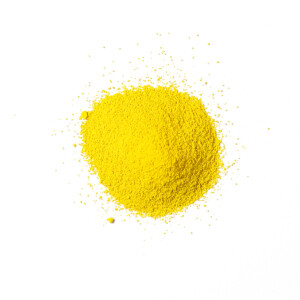Bismuth Vanadate Yellow
Artificial inorganic pigmentComposition and Properties of Bismuth Vanadate Yellow
The pigment is a salt with a formula of BiVO4. It can also be considered a mixed oxide of the elements bismuth and vanadium.
The pigment is very stable and weather-resistant, the only exception being its sensitivity to strong alkalis. It has also excellent hiding power and tinting strength. It is non-toxic and can be used as a substitute for the poisonous cadmium, chrome and lead-containing pigments such as cadmium yellow, chrome yellow and lead-tin yellow.

Pigment

Painted swatch
Names
Color Index
PY 184, CI 771740
Word origin
Bismuth: from obsolete German Bismuth, also Wismut, Wissmuth, which is of unknown origin; perhaps a miner’s contraction of wis mat “white mass,” from Old High German hwiz “white.” Latinized 1530 by Georgius Agricola (who may have been the first to recognize it as an element) as bisemutum.
From the Online Etymology Dictionary
Vanadium: from Old Norse Vanadis, one of the names of the Norse beauty goddess Freyja.
From the Online Etymology Dictionary
Bismutgelb, Wismutgelb
German
Jaune de bismuth
French
Giallo di bismuto
Italian
Amarillo de bismuto
Spanish
Preparation
The pigment can be prepared by slowly adding a solution of sodium vanadate to a solution of bismuth nitrate. The resulting precipitate is then filtered, dried and subsequently heated at 550 – 600 °C for 6 hours (1).
Bismuth vanadate can also be found in nature as the mineral pucherite.
Mineral Pucherite
 Image by Leon Hupperichs
Image by Leon Hupperichs
Video: 'The New Yellow' by Periodic Videos
History of Use
The pigment has been in use since about the second half of the twentieth century.
Identification
References
Suzuki EM, Infrared spectra of U.S. automobile original finishes (post – 1989). VIII: In situ identification of bismuth vanadate using extended range FT-IR spectroscopy, Raman spectroscopy, and X-ray fluorescence spectrometry. J Forensic Sci. 2014 Mar;59(2):344-63. doi: 10.1111/1556-4029.12318. Epub 2013 Nov 21.
Further Reading
References
(1) R. Nayak, A. Suryanarayana and S. Bhanojee Rao, Synthesis, Characterisation and Testing of Bismuth Vanadate – An Eco-friendly Yellow Pigment, Journal of Scientific and Industrial Research, Vol. 59, October 2000, pp. 833-837. Available as pdf.
S. Muntwyler, J. Lipscher, HP. Schneider, Das Farbenbuch, 2nd. Ed., 2023, alataverlag Elsau, p. 118.

